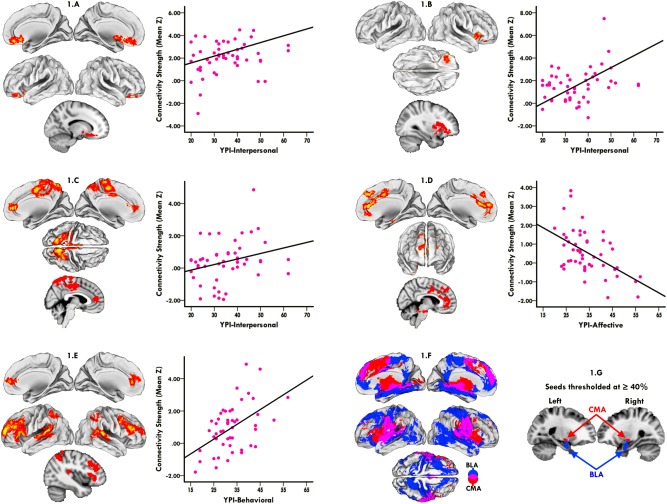Figure 1.

Dissociable relations between amygdala subregional networks and psychopathy trait dimensions. Higher levels of interpersonal traits related to increased connectivity of left BLA (1.A) and right CMA (1.B) with a network of regions accommodating reward processing, which extended from the orbitofrontal and anterior insular cortices to the nucleus accumbens, caudate, and putamen. (1.C) Higher levels of interpersonal traits additionally related to increased right CMA connectivity with a network of regions supporting sociocognitive processing, which extended from the precuneal and posterior cingulate cortices to rostral and ventral portions of the medial prefrontal territory. (1.D) In contrast, higher levels of affective traits related to diminished left CMA connectivity with a network of regions important to salience processing and affective responding, which included dorsal and ventral portions of the anterior cingulate and medial prefrontal cortices extending to the brainstem periaqueductal gray and cerebellum region. (1.E) Finally, higher levels of behavioral traits related to heightened left BLA connectivity with an executive control network that extended from the posterolateral parietal cortices to dorsolateral, ventrolateral, and rostromedial prefrontal territories. (1.F) Differential connectivity patterns of amygdala subregions, with BLA (blue) and CMA (red) target networks, and their overlap being depicted. (1.G) Representative sagittal views of BLA and CMA seeds thresholded at P ≥ 0.40. Scatterplots visualize the direction of trait‐specific associations, in which amygdalar connectivity strength (Y‐axis), indexed by Fisher's Z transformed partial correlations averaged across all illuminated voxels, is plotted against psychopathy trait scores (X‐axis). All trait‐specific connectivity effects are corrected for multiple comparisons at the cluster level (P < 0.05, initial cluster forming threshold Z > 2.3). [Color figure can be viewed at http://wileyonlinelibrary.com]
